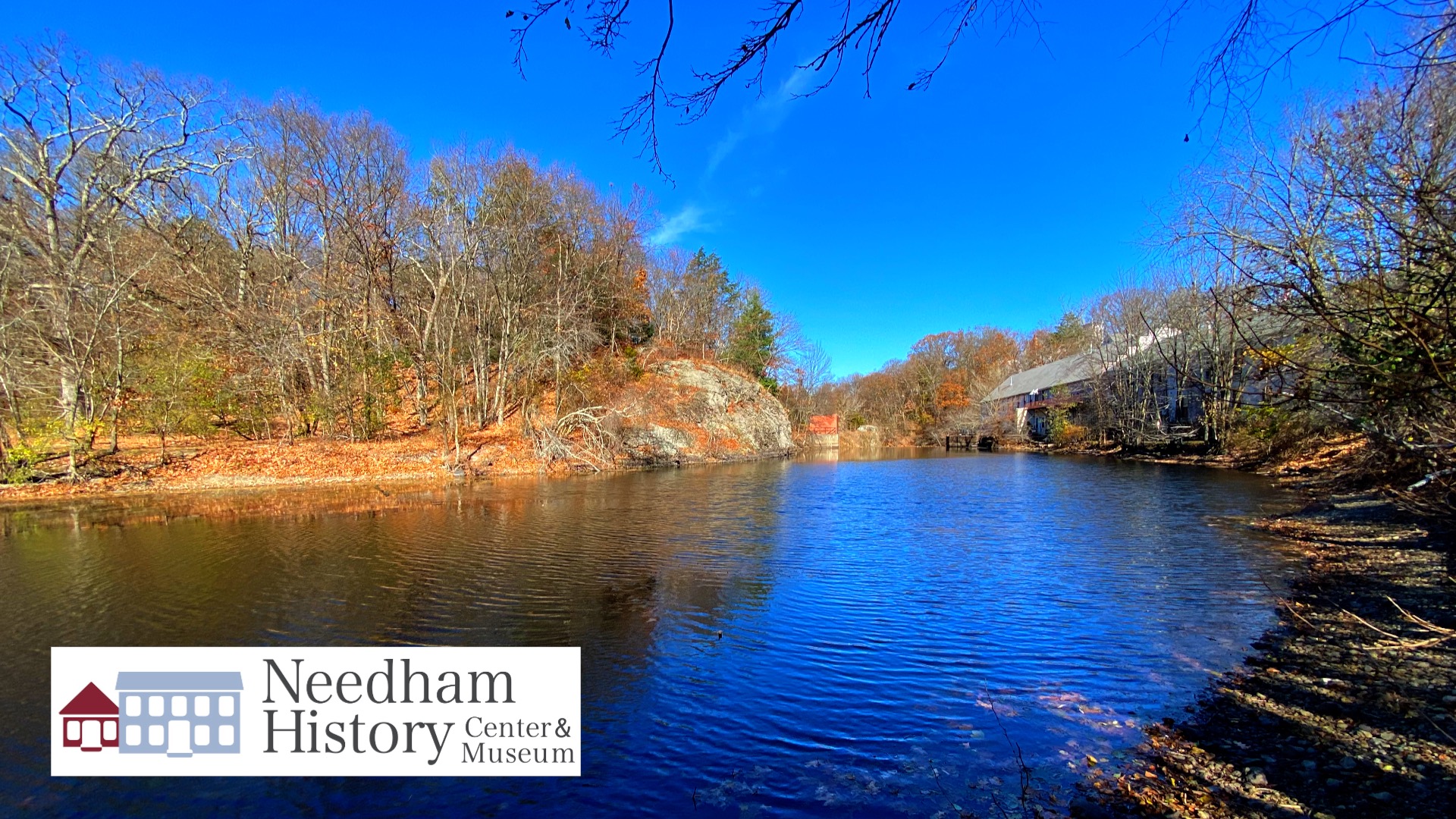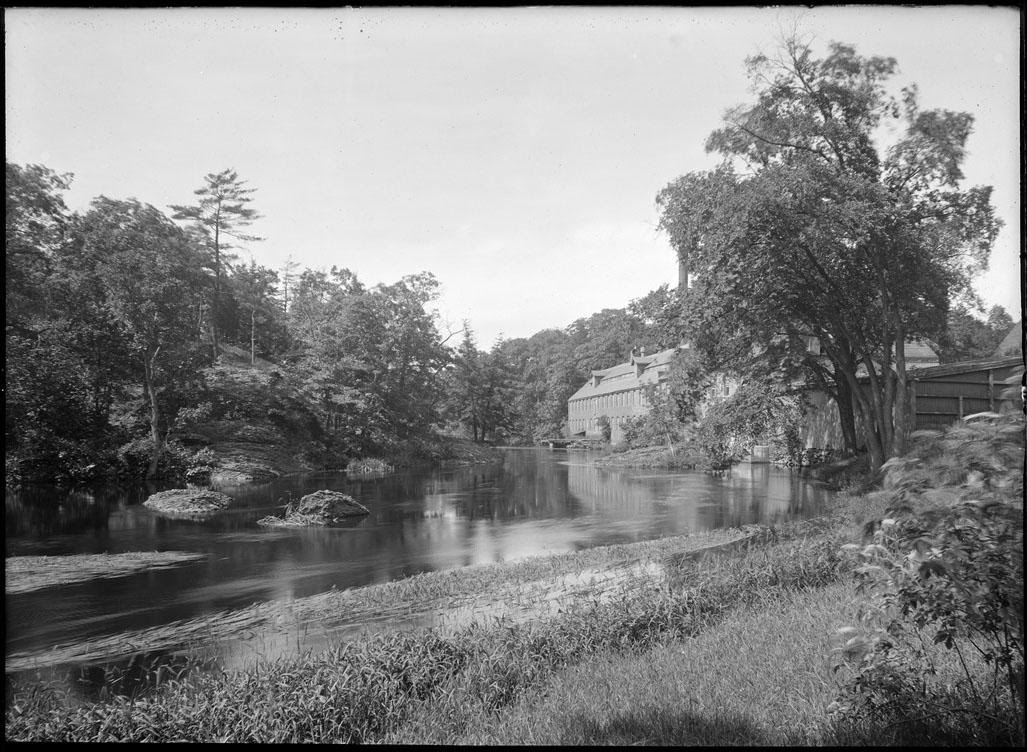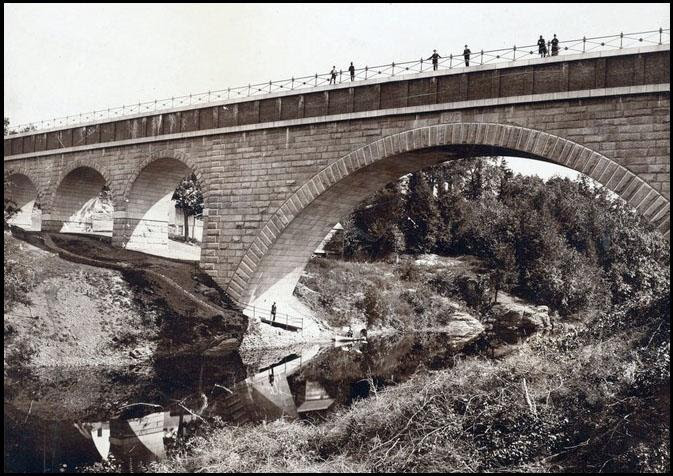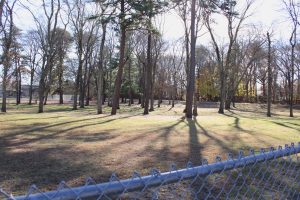
Needham History: Hemlock Gorge
One of the most beautiful spots n the Needham area.
 The view from Cook’s Bridge (Central Avenue) toward the silk mill, 1920. The large rock in the stream marks the location of the fish weir. The rock has since been removed.
The view from Cook’s Bridge (Central Avenue) toward the silk mill, 1920. The large rock in the stream marks the location of the fish weir. The rock has since been removed.
Hemlock Gorge
Hemlock Gorge, the section of the Charles River that divides Needham and Newton Upper Falls, has been in continuous use – for fishing, for industry, and most recently, for recreation – for millennia. Unlike most of the Charles, which tends to be level and sluggish, Hemlock Gorge is relatively steep, and active enough to power the small industries that clustered around its banks in the 18th and 19th centuries.
Hemlock Gorge is now a MA Department of Conservation and Recreation (DCR, formerly MDC) state park. It is 23 acres in size, bounded by Route 9 on the Wellesley side, and Central Avenue/Elliot Street on the Needham/Newton side. It is considered an “urban wild” area, crossed by several miles of walking trails with scenic views.
Before the English settlers built mills, the Gorge’s narrow and rapid channels were prime fishing grounds for Native Americans, who had lived here for thousands of years. It was a famously-good spot for trapping migratory fish (herring, alewife, and shad). The spring fish runs were so abundant, that the fish could be netted or scooped up in baskets. To make this task more efficient, fish weirs and traps – angled stone walls that acted like funnels – were built into the river bed. The weir would funnel the fish toward its narrow opening, straight into the fisher’s waiting basket. There were two known ancient fish weirs in Needham. The one in Hemlock Gorge, and another near Charles River Street. Both were used by Native Americans and later the English.
According to King’s Handbook of Newton (1899), the Hemlock Gorge weir was at “the great mid-stream rock” just below Cook’s (Central Avenue) Bridge. Walling’s 1856 map of Needham shows the rock in this location; there is also a photo of the river, dating to about 1920, that shows the rock in the stream. Later maps and a modern aerial view from Google Maps show the river running wide and clear from Cook’s Bridge to the Falls. It is likely that the rock, and possibly the weir, became obstructions and were removed to clear the channels, as the mills at the falls grew and needed as much water power as they could get.
In the early 19th century, the modest natural falls were enhanced by a dam and spillway, and used for a variety of industries – a grist mill, a cotton mill, a nail factory. The old “Stone House” on the Route 9 end is the last remnant of these manufacturing sites. Newton Conservators, a local nonprofit, has posted a website with additional resources about the park, its features, and its history, including links to Ken Newcomb’s excellent histories of the park.
The most famous feature of Hemlock Gorge is, of course, Echo Bridge, which links the Needham and Newton sides of the park. The Bridge was built in 1876 as a part of the Sudbury Aqueduct system, bringing water from Lake Cochituate to Boston. It is no longer used as a primary water supply source, but is maintained by the MWRA as part of the emergency backup system. The bridge is believed to be one of the largest stone arch structures in the world (130 feet wide and 50 feet high). The top was finished as a footbridge so people could walk across and enjoy the view. It is a popular scenic spot for daytrips and canoeing, and is especially beloved for the resounding echo (15 times!) that can be generated when standing beneath.
Something I recently learned (and I love when that happens!) – Hemlock Gorge, was, for a very brief time, an Amusement Park (and thanks to Ken Newcomb’s “Walking Tour of Hemlock Gorge” for this information). In June 1893 (three years before Norumbega Park opened, but after the Baker Estate was gone) , the land was leased to “a public-spirited gentleman” and turned into “a little fairyland” called Echo Bridge Park. Echo Bridge Park featured a Gothic-style dance pavilion and bandstand, a refreshment hall (“conducted on temperance principles”), swings, merry-go-rounds, and other amusements, as well as a broad lawn for resting, picnics, and so forth. The Park, which was open every day in the summer, was accessible by streetcar, and on a fine summer Sunday could attract as many as 5000 people.
Alas, this little fairyland was short-lived. Only two years after it opened, the land was acquired by the Metropolitan Park Commission – one of its first acquisitions. The amusement park was quickly cleared away, and Hemlock Gorge was recast by Frederick Law Olmstead into a ‘natural’ landscape in the manner of the Emerald Necklace. Hemlock Gorge was one of Olmstead’s last projects, before illness forced him to retire. Today it remains an “urban wild,” a scenic oasis, and one of the most beautiful spots in the Needham area.
Echo Bridge just after it was completed, 1878.
 |
Gloria Polizzotti Greis is the Executive Director of the Needham History Center & Museum. For more information, please see their website at www.needhamhistory.org. |

